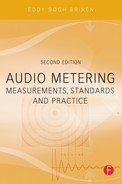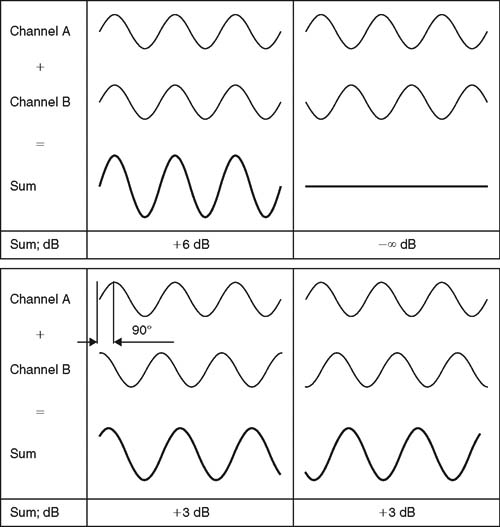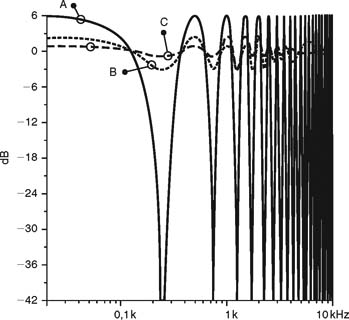Chapter | twenty-two
Summation of Audio Signals
CHAPTER OUTLINE
Electrical Summation, Correlated Signals
Electrical Summation, Uncorrelated Signals
Time Delay in a 90°Phase-Shifting Path
The summation of audio signals can be acoustic or electrical. Acoustically, it can be two sound sources in a roomrecorded at one position. Electrically, it can be two microphones that are connected to different inputs on a mixer. These signals are subsequently combined electrically and then routed to the same output.
The total level of the combined signal depends on the nature of the two signals. Some characteristic examples follow.
ELECTRICAL SUMMATION, CORRELATED SIGNALS
When signals are correlated, it means that they generally resemble each other or that they have much in common.

FIGURE 22.1A sound mixer can be regarded as a summation component.
If we imagine that a test tone is recorded on a tape recorder or another medium, for example a 1 kHz sinusoidal tone in both the left and right channels, then the signals in the two channels are correlated. In fact, they are identical: the same phase and the same level. If these signals were combined electrically into one signal, the level would be twice the level of the individual channels. Specified in dB, a doubling of the level is the same as 6 dB. (See Chapter 6 on dB.)
If, however, you have two identical signals and one of them is phase-inverted(or the phase is turned 180°) before the summation, then the result will be 0 – inother words nothing. Expressed in dB, the result would be – ∞ dB.
ELECTRICAL SUMMATION, UNCORRELATED SIGNALS
If the signals were recorded on the two tracks of a tape recorder, then there would be some noise in the form of hiss. This noise is certainly of the same magnitude on both tracks; however, it is random and hence uncorrelated. By summing the two tracks the noise level will therefore only be increased by 3 dB.
Among recording engineers, it has always been a familiar trick to record two tracks if a stereo machine is available, even if only a mono recording is to be made. The signals add to +6 dB, but the noise only adds to +3 dB. In this manner, it is possible to improve the signal-to-noise ratio by 3 dB.
SUMMATION FOR MONO
It can be practical to use a mono converter if two channels of a stereo signal are to be combined. This is the still the case when TV programs with stereo sound are to be broadcast. In some parts of the world, NICAM is used for the stereo sound; however, the original FM carrier must also be provided with sound in mono.
The simple mono converter is built so that it only takes the levels into account, in other words:
1)For stereo, random distribution of the signals: mono is L+R – 3 dB.
2)For the same signal in both channels (or highly correlated signals): mono = L+R – 6 dB.
3)A signal in only one channel: mono = L or R.
However, this form of combination does not take into account program material, where there can be significant information stored in the opposite phase. This is the case with surround programs, which are matrix-encoded down to two channels. The same applies for stereo recordings that build upon MS. Or produced stereo where the width of the acoustic image is attained by a large degree of opposite phase content from effect processors and effect devices. In these situations, the use of 90° summation is relevant.
90° Summation
For 90° summation, one of the signals is shifted by 90° at all frequencies. This means that one signal is delayed in time with respect to the other one. However, instead of a time delay that is constant at all frequencies, this involves a delay that depends on the frequency.
FIGURE 22.2 Direct summation of signals in phase and in opposite phase. The upper part of the illustration shows the direct summation. The lower part of the illustration shows the summation by the use of a 90° phase shift, where signals in both phase and opposite phase will add to the same level.
Time Delay in a 90° Phase-Shifting Path
At 20 Hz one of the signals is in principle delayed 1/20 ⋅ (90/360) s = 12.5 ms.
At 20 kHz one of the signals is in principle delayed 1/20.000 ⋅ (90/360) s = 12.5 μs.
The phase relationship between two signals a and b is significant to the final level after the summation when the following applies:
a = b·cosφ
where
φ = the phase angle (the phase between the two signals)
FIGURE 22.3 An example of one of the very few situations where a 90° summation has unfortunate consequences: Two signals are to be combined together, but there is an analog low-cut/HP filter on one of the channels. This is not clearly heard in stereo, but the channels are in opposite phase at around 115 Hz, which sounds like (and is) a lack of bass in mono.
COMB FILTERING
The filtering function that arises when a signal is added to itself after having been delayed in time is called a comb filter. The resulting frequency response resembles a comb, hence the name. The comb filter function is almost never intentional, but it is heard all the time in sound productions, where it can arise both acoustically and electrically.
Acoustically, it typically occurs when the sound on its way from source to recipient takes in part a direct path and in part an indirect path via a single reflective surface. The reflection must be attenuated at least 10 dB and preferably 15 dB in order for it not to have an effect on the sound field at the recipient position. Electrically, the phenomenon arises when two microphones with a certain distance between them capture the same signal and the level from each microphone is of the same order of magnitude.
In general: All digital signal processing takes time. This means in practice that comb filter effects can arise if you loop a signal via, for example, a compressor and combine this signal with the original.

FIGURE 22.4Two typical situations in which comb filters arise, either acoustically or electrically.
FIGURE 22.5 An example of a comb filter created by the combining of two signals with the same amplitude, but with a time delay between them of just 1 ms. A dip occurs due to cancellation at 500Hz, 1.5 kHz, 2.5 kHz, etc. The two signals add to double their value (+6 dB) at low frequencies and with a full wavelength’s delay at 1 kHz, 2 kHz, 3 kHz etc.
Dip Frequencies
Cancellation occurs for a comb filter at all the frequencies where the two signals are in opposite phase. This occurs when the time delay comprises of periods of a duration of 1/2, 1 1/2, 2 1/2, etc. At 1 kHz the period is 1 ms; half of the period is 0.5 ms. If a time delay of precisely 0.5 ms occurs, it means that cancellation will arise, not just at 1 kHz, but also at 2 kHz, 3 kHz, 4 kHz, etc.
ACOUSTIC SUMMATION OF SIGNALS
The total sound level by the acoustic summation of two sound sources, for example two monitor speakers, depends on both the signal and the acoustics. The sound sources can be correlated or uncorrelated, as mentioned previously.
The listening position (or measurement position) can be either in the direct sound field or in the diffuse sound field. In the direct sound field, there is only one sound direction. This direct field exists either in the open, in a reflectionfree room, or close to the speakers. The diffuse sound field occurs in a room when you are so far away from the speakers that the portion of direct sound is less than the sum of all the reflections. The distance from the speakers where the direct sound field and the diffuse sound field are equally large is called the critical distance. In a control room, it can typically be 1–3 meters; however, it varies with frequency. At lower frequencies the critical distance is shorter compared to that at higher frequencies. The near field in front of the speakers can be regarded as a direct field.
FIGURE 22.6 Summation of sound from two sources with the same level. The summation in the direct field will be determined by whether the sources are correlated or not. The summation in the diffuse field is independent of the correlation of the sources.




